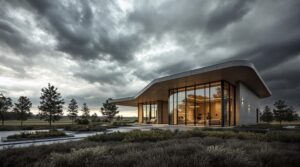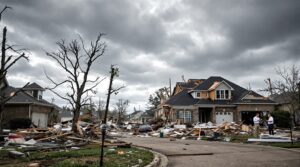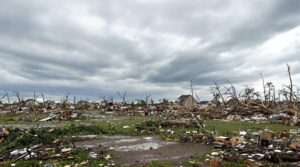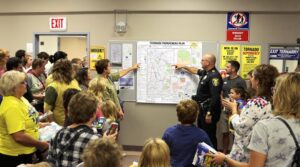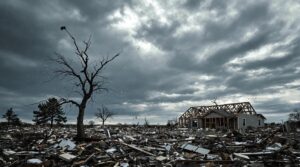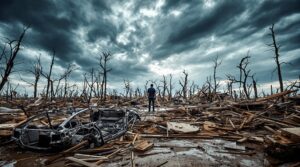EF1 tornadoes generate wind speeds between 86-110 mph, causing moderate structural damage according to the Enhanced Fujita Scale implemented in 2007. These storms typically strip roofing materials, overturn mobile homes, and snap large tree branches. From 2007-2017, EF1 tornadoes resulted in 33 fatalities and 716 injuries across the U.S. Safety protocols include seeking immediate shelter, monitoring NOAA alerts, and maintaining emergency supplies. Understanding detailed damage patterns and insurance processes proves vital for effective response and recovery.
Key Takeaways
- EF1 tornadoes generate wind speeds of 86-110 mph and can strip roofs, overturn mobile homes, and shatter windows in commercial buildings.
- Seek immediate shelter in designated safe areas, protect against flying debris, and monitor NOAA Weather Radio for emergency updates.
- Public adjusters help navigate insurance claims, with documented average payouts of $22,266 and 40% higher settlement amounts in Texas.
- Supercell thunderstorms produce EF1 tornadoes, with 2011 recording the highest annual occurrence of 638 tornadoes nationwide.
- The Enhanced Fujita Scale, implemented in 2007, classifies EF1 tornadoes as moderate damage, causing 33 fatalities from 2007-2017.
What Makes an EF1 Tornado Different
EF1 tornadoes occupy a distinct position within the Enhanced Fujita Scale, characterized by wind speeds ranging from 86 to 110 mph and classified as producing moderate damage.
These tornadoes exhibit specific tornado behavior patterns that distinguish them from other categories, particularly in their impact on structures and materials. The wind patterns of EF1 tornadoes generate sufficient force to strip materials from roofs, overturn mobile homes, and compromise exterior doors and windows. The year 2011 recorded an unprecedented 638 EF1 tornadoes, marking the highest annual occurrence on record.
Their vertical winds can lift heavy objects and people hundreds of feet, while lighter debris can be transported miles from the original location. Between 2007 and 2017, EF1 tornadoes were responsible for 33 fatalities and 716 injuries across 8,472 confirmed events in the United States, demonstrating their significant hazard potential despite being categorized as "weak" tornadoes.
The Enhanced Fujita Scale, implemented in 2007, provides more precise damage assessments compared to its predecessor, helping meteorologists better understand and classify these atmospheric phenomena.
Understanding EF1 Wind Speeds and Force

Wind speeds ranging from 86 to 110 miles per hour characterize the destructive force of an EF1 tornado, placing it firmly in the moderate damage category of the Enhanced Fujita Scale. Multiple tornado intensity factors influence these wind speeds, including atmospheric conditions and pressure gradients. The Enhanced Fujita Scale replaced its predecessor in 2007 to provide more accurate assessments.
| Wind Speed (mph) | Observable Effects |
|---|---|
| 86-90 | Large tree branches snap |
| 91-95 | Mobile homes overturn |
| 96-100 | Frame house roofs tear off |
| 101-105 | Vehicles pushed off roads |
| 106-110 | Significant structural damage |
Wind speed variations within the EF1 range demonstrate progressive destructive capability, with higher-end speeds causing more severe damage. The force exerted at these velocities generates sufficient pressure to compromise well-built structures and create dangerous wind-borne debris. Scientists measure these speeds through post-storm damage assessment, analyzing specific indicators to determine precise wind velocity ranges that caused observed destruction.
Common Types of EF1 Structural Damage
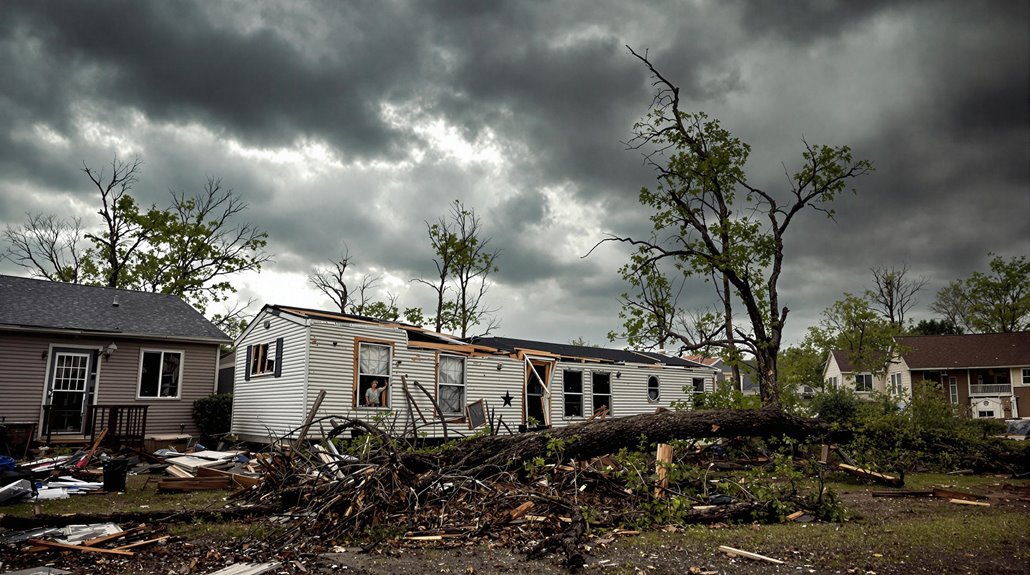
Structural damage from EF1 tornadoes manifests in distinct patterns across residential and commercial buildings, with primary impacts including severe roof stripping, compromised exterior walls, and foundation displacement.
In the tornado aftermath, wind speeds of 86-110 mph generate considerable destruction to roofing materials, while creating airborne missiles that amplify overall damage.
Assessment of structural resilience reveals that frame homes typically sustain major roof and siding damage, with possible foundation shifts.
Mobile homes prove particularly vulnerable, often experiencing complete destruction or overturning. Flying debris risks are the leading cause of injuries and fatalities during these events.
Commercial structures generally exhibit moderate damage, primarily affecting roofing systems.
Windows shatter, exterior doors detach, and substantial damage occurs to gutters and exterior cladding.
Environmental and durational factors greatly influence damage patterns, with structural integrity playing an essential role in building survival.
Large trees frequently snap or uproot during these events, contributing to the destruction through secondary impacts and debris generation.
Impact on Vehicles and Mobile Homes
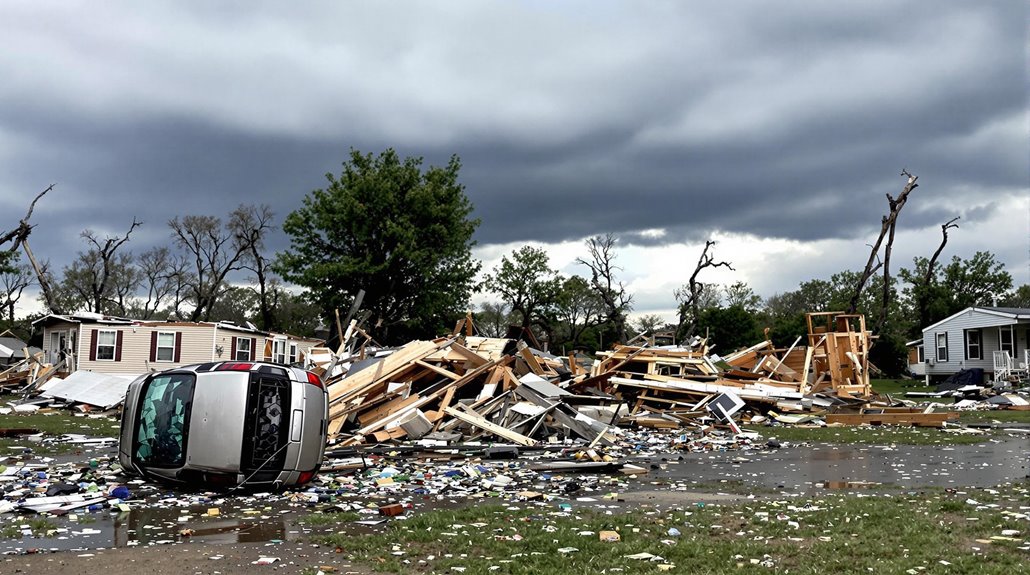
During an EF1 tornado event, vehicles and mobile homes face severe risks, with winds of 80-110 mph capable of lifting cars off the ground and completely destroying mobile home structures.
Safety protocols dictate that vehicle occupants should immediately abandon their vehicles and seek shelter in a sturdy building, as vehicles provide negligible protection against tornadic winds. Horizontal rotating columns of air create intense wind patterns that make vehicles especially vulnerable to damage.
Mobile home residents, who face a 15-20 times higher fatality risk during tornadoes, must implement thorough evacuation plans and identify nearby permanent structures for emergency shelter before severe weather strikes.
Moving Vehicle Safety Protocol
Understanding vehicle behavior in tornado conditions reveals critical displacement patterns across EF-scale intensities. Vehicle safety data indicates that EF1 tornadoes, with winds of 65-85 mph, can displace one in three vehicles. Research spanning 15 years across 959 passenger vehicles demonstrates consistent patterns in tornado-related vehicle movements. The shift in NWS safety protocols occurred after 2009, replacing outdated recommendations to abandon vehicles for outdoor ditches.
| Wind Category | Speed (mph) | Vehicle Movement | Roll Risk | Safety Protocol |
|---|---|---|---|---|
| EF0 | <65 | 1 in 10 moved | Minimal | Exit if possible |
| EF1 | 65-85 | 1 in 3 moved | ~4% | Avoid driving |
| EF2 | 86-110 | 1 in 3 moved | ~4% | Seek shelter |
| EF3-4 | 111-165 | 1 in 2 moved | ~15% | Abandon vehicle |
| EF5 | 166+ | 2 in 3 moved | ~31% | Immediate shelter |
For tornado preparedness, drivers should avoid approaching tornadoes, as rapid directional changes and vertical winds pose severe risks. Research confirms statistically similar displacement patterns across urban, suburban, and rural environments.
Mobile Home Protection Measures
While vehicle safety protocols address mobile threats during tornadoes, fixed structures like mobile homes present distinct vulnerabilities requiring specific protection measures.
Statistical data reveals mobile homes account for 54% of tornado-related fatalities despite representing only 6% of U.S. housing, with residents facing 15-20 times higher mortality risk compared to permanent structures.
- Install FEMA-approved anchoring systems to prevent bottom-up structural failure
- Establish direct access to underground storm shelters or reinforced safe rooms
- Implement real-time weather alert systems for immediate evacuation procedures
Mobile home safety fundamentally relies on proper anchoring systems and routine structural maintenance.
However, tornado preparedness extends beyond physical reinforcement, necessitating evacuation plans and access to community storm shelters.
HUD-compliant construction standards and enhanced safety features, such as wind-resistant roofing and tie-down systems, considerably improve structural resilience during EF1 tornado events.
Tree and Vegetation Destruction Patterns
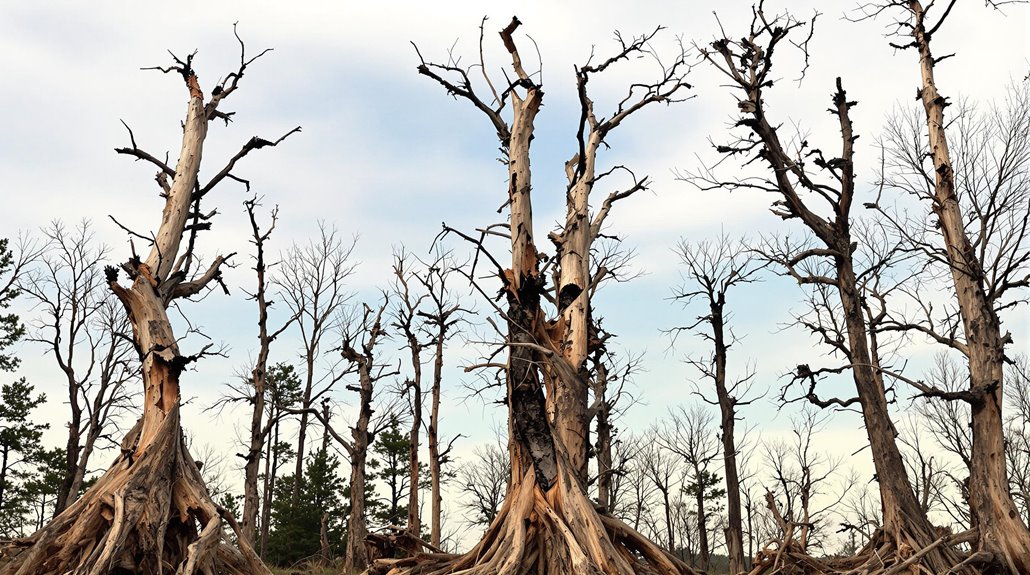
EF1 tornadoes exhibit distinctive tree breaking patterns characterized by convergent downing of vegetation and selective snapping of trunks at variable heights.
Root system damage typically manifests as partial uprooting with exposed lateral roots, while maintaining some anchor points in moderate wind conditions of 86-110 mph.
The damage assessment reveals trees are often stripped of smaller branches and leaves while retaining their primary structure, creating identifiable patterns that distinguish EF1 events from more severe tornado categories.
Tree Breaking Patterns
The distinctive breaking patterns of trees and vegetation serve as essential indicators for identifying and evaluating EF1 tornado damage.
Tree breaking patterns in EF1 tornadoes exhibit convergent characteristics, with trees typically falling in the direction of the tornado's motion. The resulting damage affects ecosystem balance, creating challenges for tree recovery and potentially enabling invasive species to establish themselves in disturbed areas.
- Trees break off or uproot at wind speeds characteristic of EF1 tornadoes
- Damage patterns show spatial variability based on terrain and local conditions
- Breaking patterns correlate with specific wind speed ranges used in EF-scale ratings
Assessment of tree damage helps meteorologists determine tornado intensity and path characteristics.
Environmental factors, including soil moisture and tree health, influence the severity of breaking patterns, while larger, healthier trees generally demonstrate greater resistance to EF1-level wind forces.
Root System Damage Characteristics
Root system destruction during EF1 tornadoes follows distinct patterns characterized by shallow uprooting and moderate structural damage to vegetation.
With wind speeds ranging from 86-110 mph, these tornadoes primarily affect trees with underdeveloped or shallow root systems, particularly younger specimens and softwood varieties. The damage typically creates convergent patterns along the tornado's path, with exposed root systems and scattered vegetation debris.
Soil conditions and moisture content greatly influence root system vulnerability, while tree size and age determine susceptibility to uprooting.
Effective vegetation management strategies, including deep planting and regular maintenance, can help strengthen root systems against EF1 tornado damage.
The impact on local ecosystems varies, with smaller and less established trees experiencing more severe uprooting than their mature counterparts.
Essential Safety Measures During an EF1 Tornado
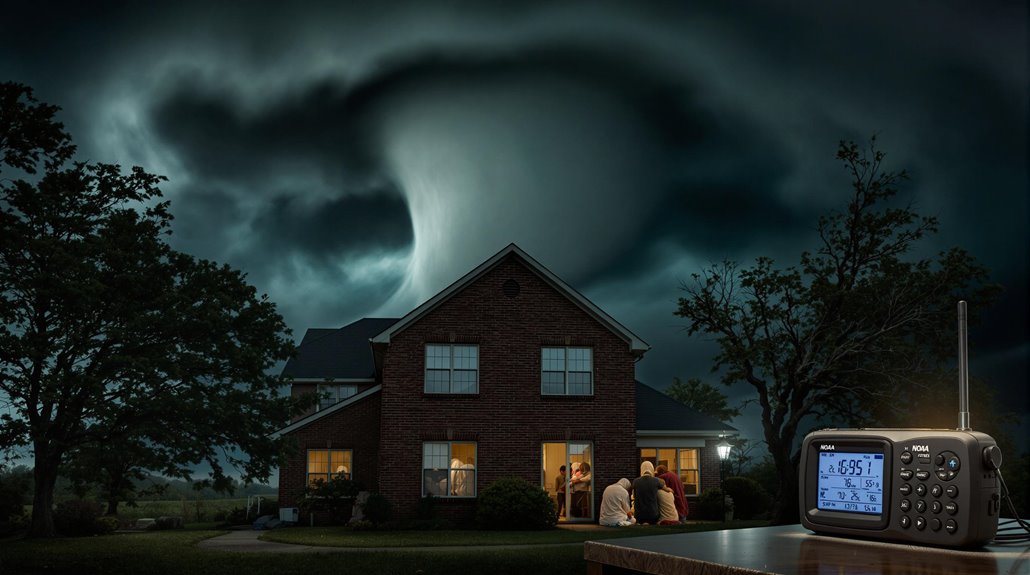
When facing an EF1 tornado with wind speeds ranging from 86 to 110 mph, implementing thorough safety measures becomes critical for survival. In such situations, securing sturdy shelters and staying away from windows can significantly reduce the risk of injury. Additionally, it’s essential to have an emergency kit readily available, complete with food, water, and first-aid supplies. For those in regions prone to severe weather, understanding ef4 tornado damage details can help underscore the importance of preparedness, as the devastation from such powerful storms can be catastrophic.
Tornado preparedness tips emphasize the immediate need to identify and access safe shelter options, including FEMA-certified safe rooms or ICC500 storm shelters. During an EF1 tornado event, individuals must proceed to the lowest level of a sturdy building, preferably in a basement or small interior room.
- Seek immediate shelter in a pre-designated safe area, avoiding open spaces, mobile homes, and vehicles.
- Protect against flying debris by covering heads with arms and additional materials such as blankets.
- Monitor NOAA Weather Radio or Emergency Alert System for real-time updates and instructions.
If caught outdoors, individuals should locate the nearest substantial building or, as a last resort, lie flat in a low-lying area while protecting their head.
Community shelters should be identified in advance, particularly for those with accessibility needs or service animals.
Creating Your Tornado Emergency Plan

Emergency preparedness mandates stocking essential survival supplies, including a minimum three-day supply of non-perishable food, one gallon of water per person per day, battery-powered weather radio, flashlights, and an extensive first-aid kit.
Families must designate two meeting locations – one nearby for sudden evacuations and another outside the neighborhood in case local access is restricted. Each family member should memorize these locations and maintain a printed emergency contact list with out-of-area contacts who can serve as central points of communication during a disaster.
Essential Safety Supplies
A thorough tornado emergency kit forms the foundation of preparedness for EF1 tornadoes and requires specific categories of essential supplies: sustenance, shelter, communication, and personal necessities.
Among the critical tornado preparedness tips, maintaining adequate emergency kit essentials guarantees survival during and after the event.
Key survival supplies include:
- Three-day supply of water (one gallon per person daily) and nonperishable food
- NOAA Weather Radio, battery-powered flashlights, and communication devices with backup power sources
- First-aid materials, prescription medications, and important documents stored in waterproof containers
The kit should be stored in an easily accessible location, regularly inspected, and updated to replace expired items.
Emergency blankets, plastic sheeting, and multi-purpose tools complete the essential inventory for thorough tornado preparedness.
Family Meeting Locations
Establishing designated family meeting locations represents a critical component of thorough tornado emergency planning. Family safety protocols should designate multiple meeting points at increasing distances from the primary residence.
Interior locations, such as a windowless basement or reinforced crawl space, serve as immediate shelter during an EF1 tornado. Secondary meeting strategies incorporate nearby landmarks like mailboxes or neighbor residences for scenarios requiring home evacuation.
For broader emergency scenarios, neighborhood gathering points such as schools, churches, or community centers provide centralized reunification options.
Distance meeting locations, positioned outside the potential impact zone, function as tertiary assembly points when neighborhood access becomes restricted. Each designated location must remain accessible to all family members and clearly communicated within the emergency response plan.
Weather Patterns That Produce EF1 Tornadoes
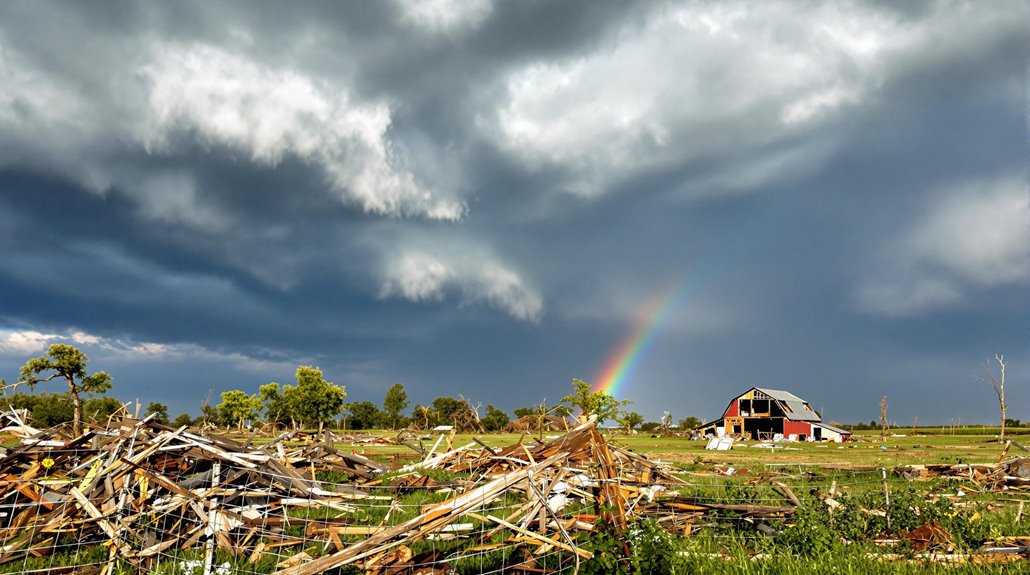
Multiple atmospheric conditions must align to produce EF1 tornadoes, with supercell thunderstorms serving as their primary formation mechanism. These storms develop when warm, humid surface air exists beneath layers of rapidly cooling temperatures aloft.
The process requires significant wind shear, particularly in the lowest few thousand feet of the atmosphere, which creates the horizontally rotating updrafts characteristic of supercell development.
Key factors that influence tornado formation:
- Mesocyclone development with rotating updrafts reaching speeds of 86-110 mph
- Temperature differentials between downdraft air and surrounding environment
- Vertical wind shear creating streamwise vorticity in air parcels
Weather conditions promoting EF1 tornadoes involve complex interactions between temperature, moisture, and wind.
The VORTEX2 research program has demonstrated that significant temperature variations aren't always necessary for tornado formation. Instead, the primary driving force comes from storm-scale factors within and around the mesocyclone, where air parcels accelerate and ascend rapidly near the rotation axis.
Notable EF1 Tornado Events and Case Studies
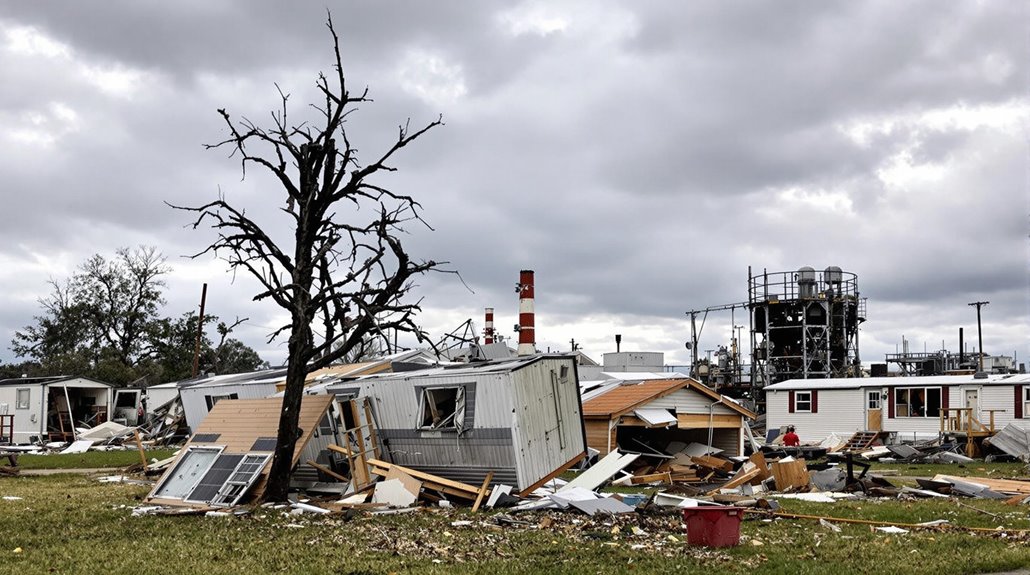
Recent documented cases of EF1 tornadoes provide valuable insights into their behavior and impact patterns. Notable events in 2023 demonstrated the widespread occurrence of these phenomena, from California's rare Montebello tornado to multiple incidents in Texas, Louisiana, and Nebraska. Case studies reveal consistent damage signatures across different geographical locations.
| Location | Date | Primary Impact |
|---|---|---|
| Montebello, CA | March 22, 2023 | Industrial facilities |
| Parker County, TX | March 24, 2023 | 100 mph winds |
| Shreveport, LA | March 2, 2023 | 100 structures |
Analysis of these events through Monte Carlo simulations has enhanced understanding of structural vulnerabilities, particularly in low-rise buildings. Research indicates that windward walls and roof components face the highest failure probability during EF1 events. With wind speeds ranging from 86-110 mph, these tornadoes consistently demonstrate the capacity to overturn mobile homes, peel off roofs, and cause significant economic damage to commercial and residential structures.
Recovery and Rebuilding After an EF1 Strike
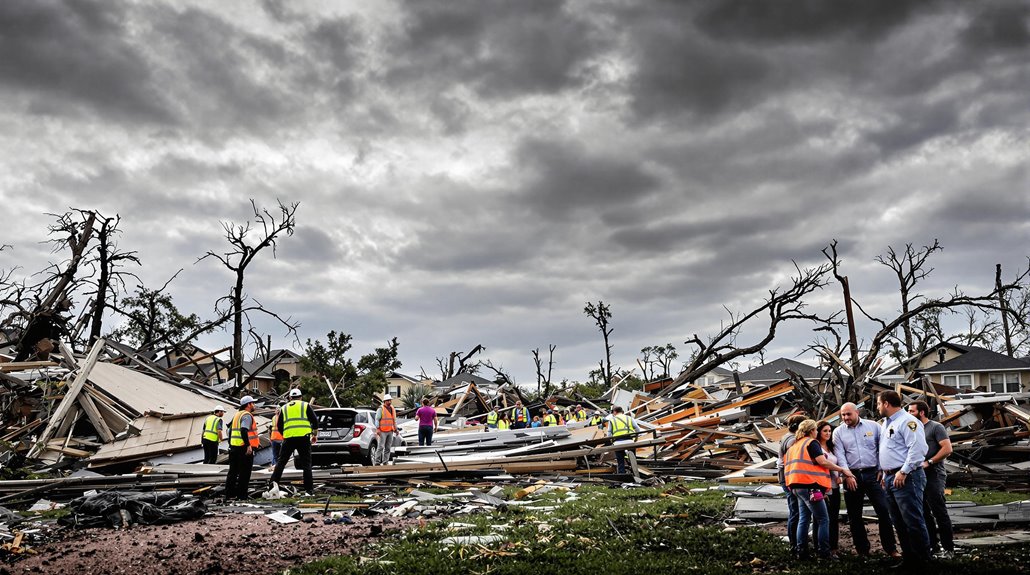
The recovery phase after an EF1 tornado strike requires systematic assessment and coordinated response across three critical domains: structural rehabilitation, resource mobilization, and community support networks.
- Initial damage assessment and emergency repairs must be completed within 24-48 hours.
- Insurance claim processes typically commence within 72 hours of the event.
- Full structural restoration generally spans 3-6 months.
Post-EF1 recovery challenges often include maneuvering through complex insurance processes, securing qualified contractors, and managing limited resources, particularly in rural areas.
Community resilience emerges through collaborative partnerships between local nonprofits, government agencies, and volunteer organizations, which facilitate access to critical resources and financial assistance programs.
The emotional recovery process requires sustained support systems, as communities work to rebuild both physical infrastructure and social connections.
Safety protocols, including professional structural assessments and utility inspections, form the foundation of the rebuilding process, while organized volunteer efforts help accelerate restoration timelines through coordinated labor and resource distribution.
Working with a public insurance adjuster can help maximize settlement amounts for tornado-related property damage claims.
Technology for EF1 Tornado Detection
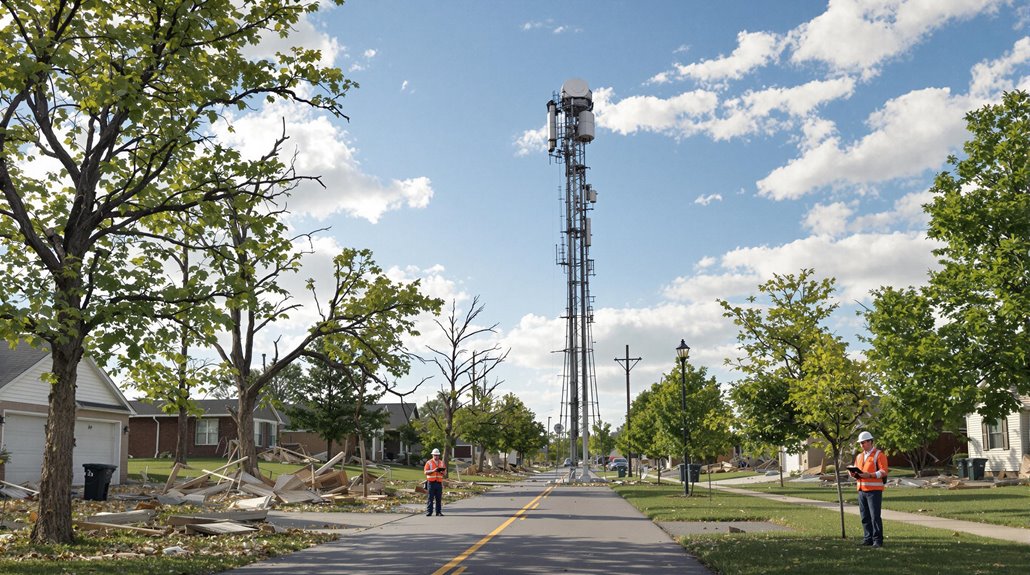
Modern tornado detection technology integrates artificial intelligence, machine learning algorithms, and advanced radar systems to identify and classify EF1 tornadoes with increasing precision. Current AI-driven systems demonstrate a 50% accuracy rate in detecting EF1 tornadoes, while achieving over 85% accuracy for stronger tornadoes rated EF2 and above.
The Tornado Probability Algorithm (TORP) employs random forest machine learning techniques to analyze data from dual-polarization WSR-88D radar systems. This technology processes tornadic debris signatures (TDS) and storm-scale processes in real-time, utilizing Level-II radar data collected over a decade of storm events.
The open-source TorNet dataset has enabled global collaboration in refining these detection methods.
While challenges persist in distinguishing EF1 intensity levels from other classifications, machine learning advancements continue to improve operational tornado detection capabilities through enhanced radar interpretation and probabilistic analysis.
Future Trends in EF1 Tornado Research
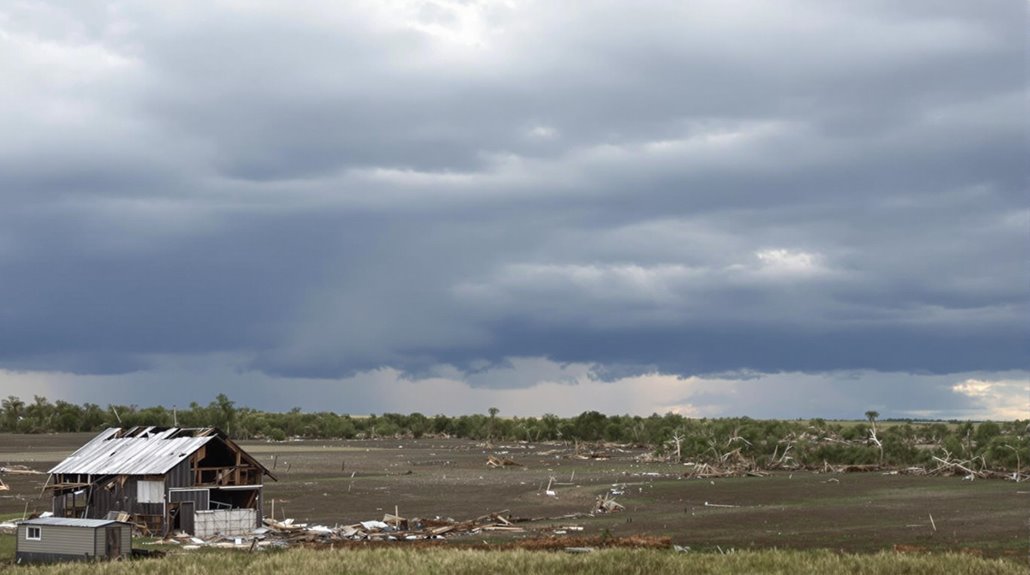
Emerging research indicates significant shifts in EF1 tornado patterns, with data revealing a decrease in annual tornado days from 146 (1954-1974) to 104 (1996-2016), coupled with an increase in outbreak intensity.
Seasonal variability studies demonstrate declining summer and spring tornado frequencies, while fall and winter events are becoming more prevalent. This shift challenges traditional tornado prediction models and necessitates adaptive forecasting strategies.
Key developments in tornado research include:
- Intensification of outbreak events, with days featuring 16+ EF1 tornadoes doubling to 7 per year since 2000
- Increase in tornadoes per event day from 3.6 to 4.4 (1996-2016)
- Notable expansion in tornado path dimensions and apparent rating changes after EF-scale implementation
Research initiatives like TORUS and VORTEX-SE are investigating these trends, particularly focusing on environmental factors affecting formation and trajectory.
These programs aim to enhance forecast accuracy and improve public safety through advanced warning systems.
The Benefits Of Consulting A Public Adjuster
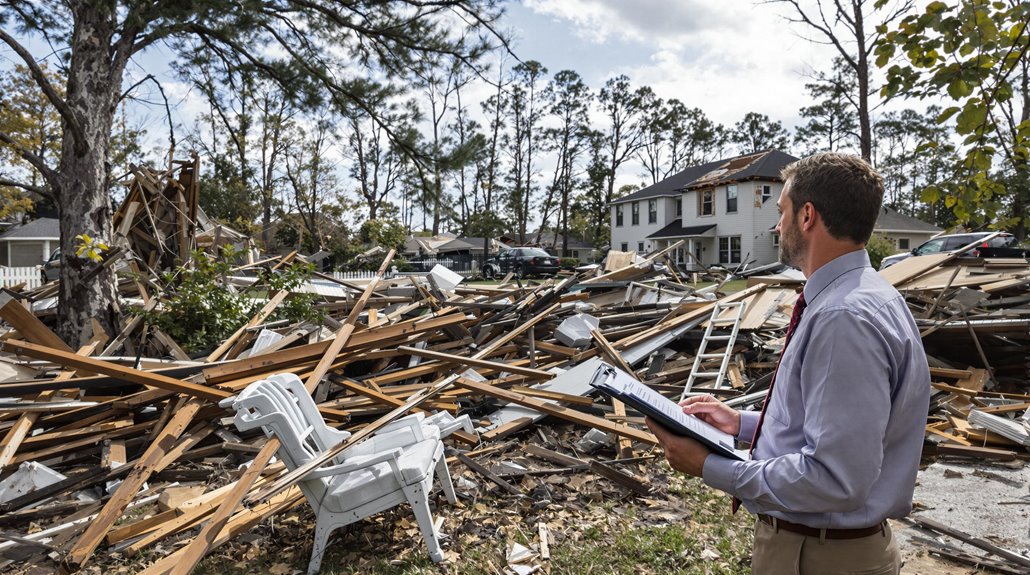
Public adjusters bring specialized expertise in interpreting complex insurance policies and documenting EF1 tornado damage claims with technical precision and thoroughness.
Their objective assessment methods and established protocols for damage evaluation typically result in more extensive claim documentation compared to policyholder-submitted claims.
Statistical evidence indicates that professionally managed claims through public adjusters often lead to notably higher settlement amounts, with studies showing increases of up to 747% in catastrophic damage cases.
For maximum benefit, early adjuster involvement is crucial immediately after tornado damage occurs to ensure comprehensive documentation of all losses and prevent potential complications in the claims process.
Expertise In Insurance Claims
When dealing with tornado-related insurance claims, consulting a licensed public adjuster provides significant advantages due to their specialized expertise in policy interpretation and claims management.
These professionals possess extensive knowledge of insurance policies, procedures, and negotiation strategies, ensuring policyholders receive maximum compensation for their losses.
- Professional documentation and claim presentation methods that accurately capture all tornado-related damages
- Strategic policy analysis techniques that identify all eligible coverage benefits
- Expert negotiation skills backed by in-depth understanding of insurance company protocols
Through their systematic claims process management, public adjusters streamline documentation requirements, handle complex negotiations, and advocate for fair settlements.
Their expertise proves particularly valuable in tornado damage scenarios, where accurate damage assessment and thorough policy understanding directly impact claim outcomes.
Working on a contingency fee basis, public adjusters typically charge 5-20% of the final settlement amount, making their services accessible to property owners facing tornado damage.
Objective Damage Assessment
To guarantee accurate assessment of tornado-related damages, professional public adjusters employ systematic evaluation protocols that include structural analysis, hidden damage detection, and thorough documentation methods.
Their extensive damage assessment approach utilizes F-scale guidelines to determine wind event magnitude and identify potential structural vulnerabilities that may not be immediately visible.
Public adjusters meticulously document all findings to support insurance claims, examining complex aspects such as roof integrity, structural displacement, and debris impact patterns.
This objective evaluation process guarantees that all damages are properly cataloged and quantified according to established insurance industry standards.
Their expertise in translating technical findings into detailed claim documentation helps maximize compensation while adhering to policy requirements and coverage limits, providing property owners with scientifically sound assessments that withstand scrutiny during the claims process.
Unlike insurance adjusters who serve company interests, public adjuster advocacy ensures policyholders receive fair settlements that reflect the true extent of tornado damage.
Streamlined Claim Process
A substantial majority of policyholders benefit from streamlined claim processing when consulting professional public adjusters during tornado-related incidents.
These insurance advocacy specialists facilitate efficient claim management through expert policy interpretation, thorough documentation, and skilled negotiation strategies, greatly reducing processing time and policyholder stress levels.
- Public adjusters implement systematic documentation protocols, ensuring all tornado damage is accurately assessed and recorded according to EF Scale parameters.
- They provide 24/7 emergency response capabilities, initiating immediate claim procedures following tornado events.
- Their expertise in regulatory compliance and policy interpretation minimizes the risk of claim denials or underpayments.
Through their specialized knowledge of tornado-specific damage patterns and insurance requirements, public adjusters navigate complex claim processes while maintaining strict adherence to policy guidelines and legal frameworks.
With settlement fees ranging from 5% to 15% of total compensation, public adjusters consistently deliver value through their comprehensive claim management services.
Higher Claim Payouts & Settlements
Public adjusters demonstrably increase settlement amounts for tornado-related insurance claims through their specialized expertise and strategic negotiation capabilities.
Studies indicate significant financial benefits, with data from Florida showing average payouts of $22,266 for claims handled by public adjusters compared to $18,659 without their services. In Texas, claim negotiation efforts resulted in a 40% increase in settlement amounts.
These professionals employ sophisticated settlement strategies, including thorough damage documentation and collaboration with forensic accountants and building estimators.
Working on a contingency basis, typically capped at 10% of the settlement, public adjusters identify hidden damages and advocate exclusively for policyholders' interests.
Their objective approach and specialized knowledge in valuing complex damages guarantees maximum compensation while eliminating the emotional burden of claim management for property owners.
About The Public Claims Adjusters Network (PCAN)
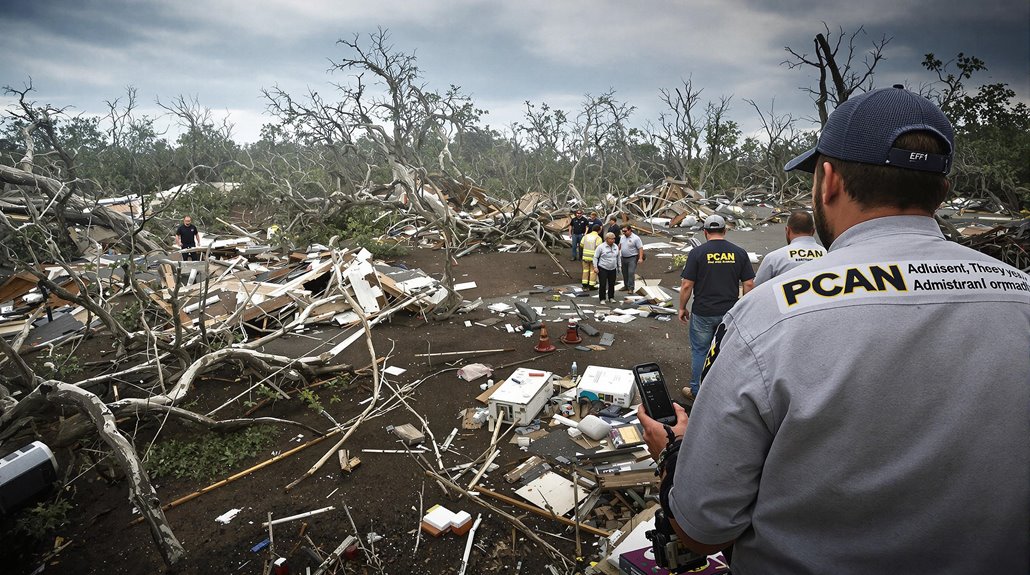
The Public Claims Adjusters Network (PCAN) operates as a nationwide coalition of state-licensed professionals specializing in policyholder representation during insurance claim processes. Their services encompass thorough claim documentation, construction estimating, and total cost analysis for both residential and commercial properties, with proven results showing 300-400% increased settlement rates for clients.
Key benefits of PCAN's services include:
- Expert damage assessment using industry-leading software to identify visible and concealed losses
- Specialized assistance for business interruption claims and CPA earning analysis
- No upfront fees, with payment contingent upon successful claim settlements
PCAN adjusters utilize advanced technology, including Claim Wizard CRM, to guarantee precise documentation and expedited claims processing. Their disaster recovery services extend beyond basic claims management, offering emergency mitigation and temporary housing assistance.
As independent representatives, PCAN professionals maintain a commitment to policyholder advocacy, providing continuous support from initial assessment through final settlement.
Frequently Asked Questions
Can Pets Sense an Approaching Tornado Before Humans Can?
Scientific evidence supports that animal instincts enable pets to detect approaching tornadoes through barometric pressure changes, electrostatic variations, and atmospheric alterations before human perception of tornado behavior manifests.
How Long Does the Average EF1 Tornado Stay on the Ground?
EF1 tornado duration typically ranges from a few minutes on the ground, with approximately 75% of these tornadoes traveling one mile or less before dissipating, based on observed characteristics.
Do Tornadoes Really Sound Like Freight Trains Approaching?
Scientific observations confirm that tornado sounds frequently match freight train acoustics, producing low-frequency rumbles and roars due to high-velocity winds and pressure changes within the funnel structure.
Can EF1 Tornadoes Occur at Night, and Are They More Dangerous?
While EF1 tornadoes occur during both day and night, nighttime tornadoes prove considerably deadlier, causing 39.3% of fatalities despite representing only 27.3% of occurrences. Enhanced tornado safety measures become essential after dark.
Why Do Some Houses Remain Untouched While Neighboring Homes Suffer Damage?
Selective tornado damage occurs due to variations in local wind speeds, building materials, landscape features, structural integrity, and debris patterns within small geographic areas, creating inconsistent damage distribution between adjacent properties.
References
- https://homework.study.com/explanation/what-is-an-ef-1-tornado.html
- https://www.iccsafe.org/building-safety-journal/bsj-dives/how-damage-determines-a-tornados-rating-from-fujita-to-enhanced-fujita/
- https://sanduskycountyoh.gov/uploads/PDF/TornadoFacts.pdf
- https://grademiners.com/blog/writing-a-good-tornado-research-paper
- https://rainbowrestores.com/blog/what-is-the-fujita-scale
- https://www.factsjustforkids.com/weather-facts/ef1-tornado/
- https://www.weather.gov/mkx/taw-tornado_classification_safety
- https://www.ready.gov/tornadoes
- https://atlassaferooms.com/what-is-the-ef-scale-for-tornados/
- https://www.weather.gov/oun/efscale


